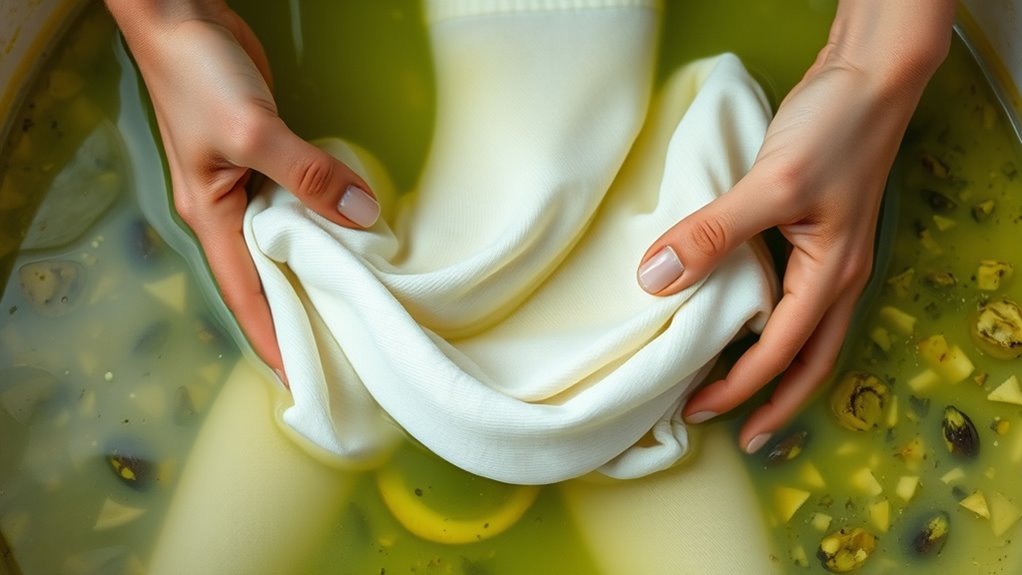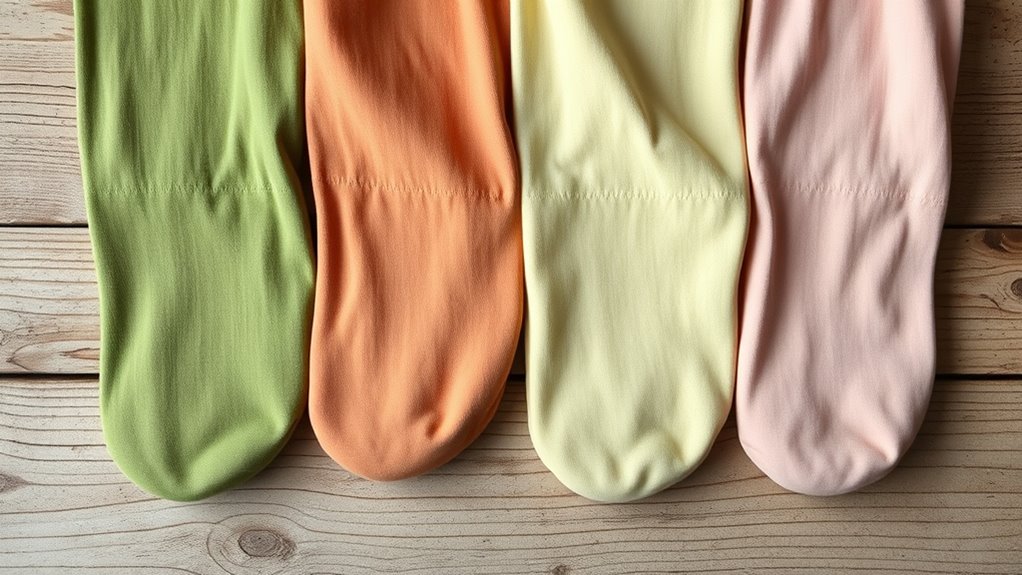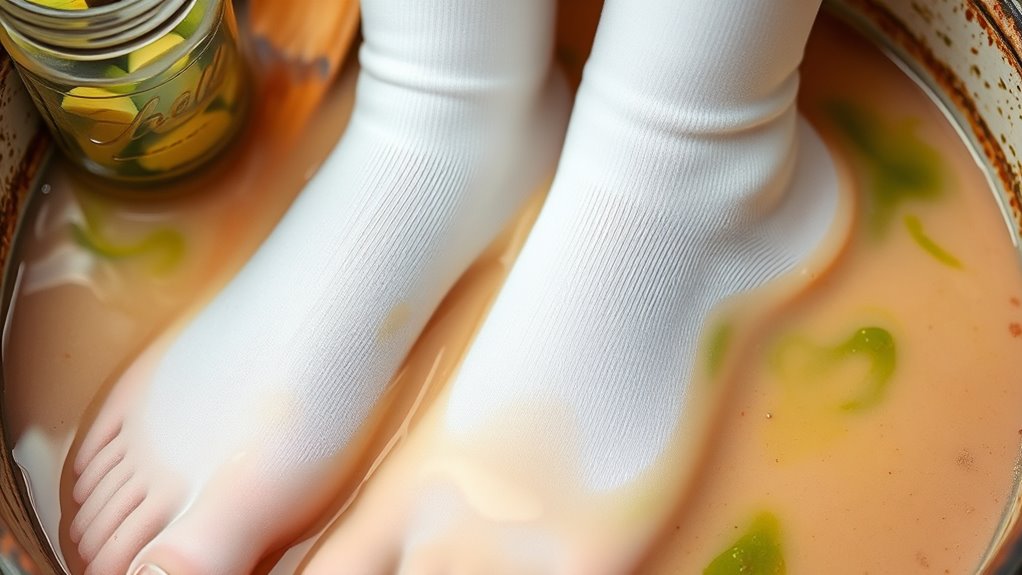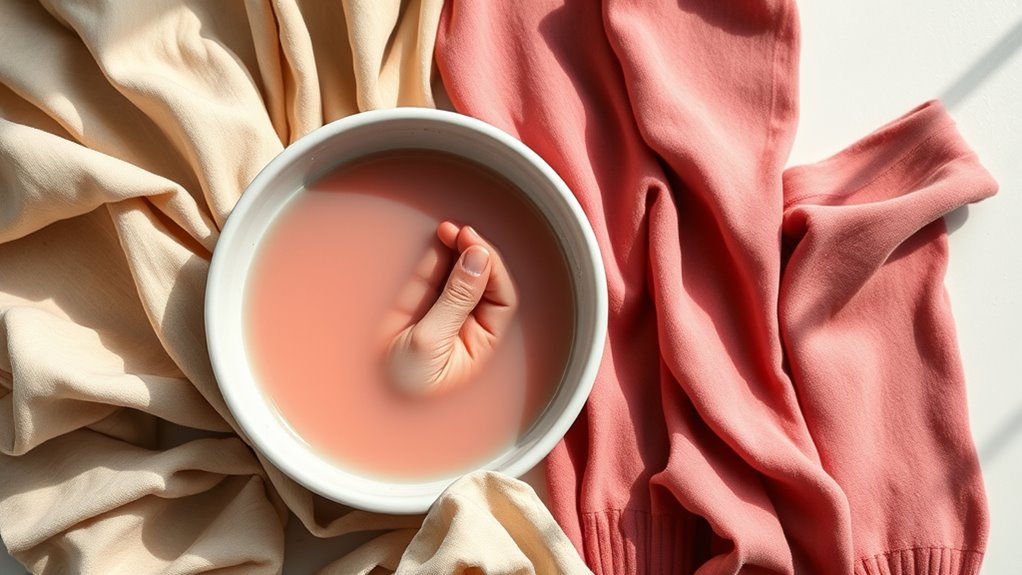To dye your cotton tights naturally with avocado pits, start by extracting dye from chopped pits boiled in water for 30-60 minutes. Prepare your tights by soaking them in warm water and mordanting if desired. Submerge the damp tights in the dye bath, stirring gently for even color. Adjust shades by changing immersion time or dipping multiple times. Once you’re satisfied, rinse, dry in shade, and properly care for your vibrant, eco-friendly tights—there’s more to discover to perfect your technique.
Key Takeaways
- Prepare natural cotton tights by washing thoroughly and soaking in warm water for optimal dye absorption.
- Extract avocado pits by chopping and simmering in water for 30-60 minutes to create the dye bath.
- Fully submerge the damp tights in the dye bath, agitating gently for even color uptake.
- Rinse the dyed tights with cool water until clear, then air dry away from direct sunlight for best colorfastness.
- Enhance color longevity by washing with mild detergent and storing in a cool, dark place.
Gathering and Preparing Your Materials

To begin your natural dyeing project, gather all the necessary materials. You’ll need a natural fiber like cotton tights, since synthetic fibers don’t absorb dye well. Select fresh or dried avocado pits for the dye source, ensuring they’re clean and free of debris. Prepare gloves and a strainer to handle the natural dye safely. It’s also helpful to have a mordant, such as alum, to improve color fastness on your fabric. Keep your workspace organized and clean to prevent contamination. Before starting, wash your cotton tights thoroughly to remove any finishes or residues that might interfere with dye absorption. Additionally, understanding how natural dyes work can help you achieve more vibrant and lasting colors. By preparing these materials in advance, you set the foundation for vibrant, long-lasting color that adheres well to the fabric and maintains its hue over time.
Extracting and Boiling the Avocado Pits

Start by extracting the avocado pits from their skins, making sure they are clean and free of any flesh or debris. Rinse them thoroughly to remove residue, which helps prevent contamination during boiling. Next, chop the pits into smaller pieces to speed up the extraction process. Place the pieces in a pot and cover them with water. Bring the water to a gentle boil, then simmer for about 30-60 minutes, stirring occasionally. This boiling process releases the natural dye from the pits. During extraction, consider fiber pre treatment, as it can enhance color fixation on your cotton tights. Additionally, understanding arcade machine mechanics can inspire creative projects, such as designing your own custom dyeing tools. Once the dye bath is ready, strain out the solids and proceed with dyeing. Proper extraction ensures vibrant, lasting color and promotes better fiber dye uptake.
Pre-treating Your Cotton Tights for Dyeing

Before dyeing, it’s important to pre-treat your cotton tights to guarantee the color bonds well and lasts longer. Proper fabric preparation ensures the dye fixes effectively. Start by soaking your tights in warm water to remove any residues and to dampen the fabric, which helps the dye absorb evenly. Next, apply a mordant or a fixative like alum or vinegar to improve dye fixing and enhance color intensity. This step helps the dye adhere better to the fibers, reducing fading over time. Gently squeeze out excess water without wringing. When your tights are prepared and slightly damp, they’re ready for the dyeing process, ensuring vibrant, long-lasting color. Proper pre-treatment is key to achieving beautiful, durable results in natural dyeing. Understanding the role of automation in dyeing techniques can help optimize the process for better color fixation and longevity.
Dyeing Process: Submerging the Tights in the Avocado Dye

Make sure you fully submerge your tights in the avocado dye to guarantee an even color. Keep them moving gently to avoid uneven patches. This helps you achieve a consistent, beautiful finish on your cotton tights. Additionally, monitoring the dyeing process ensures the color develops evenly, much like maintaining proper storage conditions for other natural dyes.
Proper Submersion Technique
To guarantee even and vibrant color absorption, carefully submerge your cotton tights into the avocado dye bath, making sure they are fully immersed without tangling. Handle the fabric gently to prevent uneven dye fixation, ensuring all areas are equally exposed to the dye. Before submersion, confirm your fabric preparation is complete—soaking the tights in water helps the dye adhere better. As you submerge, gently agitate the tights to promote uniform dye absorption and prevent air pockets. Keep the tights submerged for the recommended time, avoiding movement that could cause uneven coloring. Proper submersion ensures the dye penetrates evenly, resulting in a consistent and vibrant hue. Additionally, maintaining a consistent temperature during dyeing can enhance color fidelity and overall dye uptake. Following this technique helps achieve the best results while maintaining the integrity of your fabric.
Maintaining Even Color
Once your tights are fully submerged in the avocado dye bath, it’s important to monitor their position and movement to maintain an even color. Gently stir or agitate the tights periodically to prevent dye migration from concentrated areas, ensuring consistent color saturation. Keep the tights submerged and avoid letting them rest on the sides or bottom of the container, as uneven exposure can cause patchy results. If you notice certain areas becoming darker, adjust the tights to distribute the dye evenly. Consistent movement helps promote uniform dye absorption, reducing the risk of streaks or uneven patches. Remember, patience is key—allow sufficient time for the dye to set evenly, resulting in a beautifully uniform hue across your cotton tights. Additionally, understanding how popular juice brands offer natural flavors without added sugars can inspire you to use more organic ingredients in your dyeing process for a safer, eco-friendly project.
Achieving Different Shades Through Time and Technique

You can create a range of shades by adjusting your dyeing technique. Extending the soaking time deepens the color, while multiple dips build intensity. For lighter hues, try shorter soaking periods or fewer dips to achieve the desired effect. Incorporating mindful decluttering strategies can help you organize your supplies and keep your workspace efficient during your dyeing projects.
Extended Soaking for Depth
Extending the soaking time allows the dye to penetrate deeper into the cotton fibers, resulting in richer and more varied shades. The longer your tights soak, the more the color saturates the fabric, enhancing the overall intensity. This increased contact time improves color saturation and helps achieve a more uniform, vibrant hue. Additionally, prolonged soaking can improve dye stability, reducing the likelihood of fading over time. Keep in mind that patience pays off—testing different durations can help you find the perfect shade depth. Be sure to occasionally check the fabric to prevent over-soaking, which may lead to uneven color distribution. Ultimately, extended soaking is a simple yet effective way to deepen your dye’s impact and create more durable, beautifully colored cotton tights. Incorporating dye fixation techniques can further enhance the longevity of your dyed tights.
Multiple Dips, Lighter Shades
By applying multiple dips into the dye bath, you can achieve a range of lighter shades and subtle color variations on your cotton tights. Repeated dips allow you to control dye saturation, creating soft, layered effects through gradual color blending. To maintain dye stability, wait for each dip to cool before re-dipping, preventing uneven color and ensuring consistent results. This technique can produce a delicate gradient or pastel tones, depending on how many dips you perform and the duration of each. Keep in mind that the more you dip, the lighter the shade becomes, as the dye gradually fades. Experiment with timing and number of dips to find your perfect shade. Additionally, understanding dye absorption helps in predicting how the fabric will react during multiple dips, ensuring better control over the final color.
Rinsing and Drying Your Dyed Tights

After dyeing your cotton tights, rinsing them thoroughly is essential to remove excess dye and set the color. Use cool water to gently rinse until the water runs clear, which helps prevent color bleeding during future wears. This step also aids in stain removal, ensuring no leftover dye stains your skin or other clothing. Be careful not to twist or wring the tights, as this can distort their shape and cause uneven color. Instead, gently squeeze out excess water and lay them flat on a clean towel to dry. Avoid direct sunlight, which can fade the dye. Allow your tights to air dry completely before wearing, ensuring the color is fixed and vibrant. Proper rinsing and drying preserve your dye job and keep your tights looking fresh. Additionally, proper maintenance of dyed fabrics helps prolong the intensity of the color and overall garment lifespan.
Tips for Enhancing and Extending Colorfastness

To keep your dyed tights vibrant and prevent fading, it’s important to take steps that enhance their colorfastness. Start by using natural mordants like alum or iron to set the dye and improve durability. These natural mordants help fix the color, making it less likely to wash out over time. Additionally, wash your tights in cold water with a gentle, pH-neutral detergent to preserve the color. Avoid harsh chemicals and bleach, which can strip the dye. Once dyed, consider soaking your tights in a vinegar or salt solution as a natural way to boost colorfastness. Incorporating these colorfastness tips ensures your tights stay vibrant longer while maintaining the integrity of your natural dye.
Caring for Your Naturally Dyed Cotton Tights

Proper care is key to keeping your naturally dyed cotton tights looking vibrant and fresh. To maintain fabric softness, wash your tights in cold water using a gentle, natural detergent. Avoid harsh chemicals or bleach, which can damage the dye and weaken the fibers. Turn the tights inside out before washing to protect the color and reduce fading. Air drying is best—lay them flat or hang in a shaded area—since direct sunlight can cause colors to fade over time. Store your tights in a cool, dark place to preserve their hue and prevent unnecessary wear. With proper care, you’ll enjoy the color longevity and softness of your DIY dyed tights, keeping them beautiful and comfortable for many wears.
Frequently Asked Questions
How Long Does the Avocado Dye Typically Last on Cotton Tights?
You might wonder about dye longevity and how long the color lasts on your cotton tights. Typically, avocado dye can stay vibrant for several washes, but some color fading is normal over time. To maximize dye stability, wash your tights in cold water and avoid harsh detergents. With proper care, you can enjoy the rich hue for up to 8-10 wears before noticeable fading occurs.
Can I Mix Avocado Dye With Other Natural Dyes for Unique Colors?
Think of dye mixing like blending a painter’s palette—you can create stunning, one-of-a-kind hues. You can absolutely mix avocado dye with other natural dyes to achieve unique colors. Just keep in mind that color mixing might affect dye stability, so test small batches first. This way, you’ll guarantee your vibrant new shades stay bright and beautiful on your cotton tights. Experimenting is part of the fun!
Is There a Specific Type of Cotton Fabric That Absorbs Avocado Dye Better?
When choosing cotton fabric types, you’ll find that those with a tighter weave, like combed cotton or sateen, generally have better dye absorption rates. These fabrics allow the avocado dye to penetrate more evenly, resulting in richer, more vibrant colors. Looser weaves, like gauze or muslin, tend to absorb less dye and produce softer hues. So, for best results, opt for tightly woven cotton fabrics to maximize dye absorption.
How Do Environmental Factors Like Sunlight Affect the Dyed Color?
You might think sunlight exposure would make your dyed fabric glow, but it actually causes fabric fading. Sunlight breaks down dye molecules, dulling vibrant colors and washing out your effort. So, if you want your avocado-dyed cotton tights to stay lively, keep them out of direct sunlight or store them in a dark place. Ironically, what’s supposed to brighten your day can silently fade your beautiful dye job.
Can the Dyeing Process Be Safely Done Indoors Without Ventilation?
You can safely dye indoors, but you should consider ventilation concerns. Proper indoor safety means opening windows or using a fan to circulate air and prevent fumes from building up. While natural dyes are generally safe, some ingredients or tools might emit odors or particles. Ensuring good airflow helps protect your health, making your DIY project safer and more enjoyable. Always prioritize ventilation to avoid any indoor safety issues.
Conclusion
Now that you’ve dyed your cotton tights with avocado pits, enjoy the beauty of your eco-friendly creation. Embrace the uniqueness of each shade, appreciate the process from start to finish, and cherish the natural glow of your handmade piece. Keep experimenting, keep caring, and keep loving your sustainable fashion. Remember, each step is a chance to learn, each dyeing session a chance to grow, and every finished item a reflection of your creativity and commitment to the environment.









